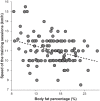Running speed during training and percent body fat predict race time in recreational male marathoners
- PMID: 24198587
- PMCID: PMC3781899
- DOI: 10.2147/OAJSM.S33284
Running speed during training and percent body fat predict race time in recreational male marathoners
Abstract
Background: Recent studies have shown that personal best marathon time is a strong predictor of race time in male ultramarathoners. We aimed to determine variables predictive of marathon race time in recreational male marathoners by using the same characteristics of anthropometry and training as used for ultramarathoners.
Methods: Anthropometric and training characteristics of 126 recreational male marathoners were bivariately and multivariately related to marathon race times.
Results: After multivariate regression, running speed of the training units (β = -0.52, P < 0.0001) and percent body fat (β = 0.27, P < 0.0001) were the two variables most strongly correlated with marathon race times. Marathon race time for recreational male runners may be estimated to some extent by using the following equation (r (2) = 0.44): race time ( minutes) = 326.3 + 2.394 × (percent body fat, %) - 12.06 × (speed in training, km/hours). Running speed during training sessions correlated with prerace percent body fat (r = 0.33, P = 0.0002). The model including anthropometric and training variables explained 44% of the variance of marathon race times, whereas running speed during training sessions alone explained 40%. Thus, training speed was more predictive of marathon performance times than anthropometric characteristics.
Conclusion: The present results suggest that low body fat and running speed during training close to race pace (about 11 km/hour) are two key factors for a fast marathon race time in recreational male marathoner runners.
Keywords: anthropometry; athlete; body fat; endurance; skinfold thickness.
Figures



Similar articles
-
Prediction of half-marathon race time in recreational female and male runners.Springerplus. 2014 May 16;3:248. doi: 10.1186/2193-1801-3-248. eCollection 2014. Springerplus. 2014. PMID: 24936384 Free PMC article.
-
Comparison of anthropometric and training characteristics between recreational male marathoners and 24-hour ultramarathoners.Open Access J Sports Med. 2012 Oct 23;3:121-9. doi: 10.2147/OAJSM.S37389. eCollection 2012. Open Access J Sports Med. 2012. PMID: 24198595 Free PMC article.
-
Predictor variables for half marathon race time in recreational female runners.Clinics (Sao Paulo). 2011;66(2):287-91. doi: 10.1590/s1807-59322011000200018. Clinics (Sao Paulo). 2011. PMID: 21484048 Free PMC article.
-
Physiology and Pathophysiology in Ultra-Marathon Running.Front Physiol. 2018 Jun 1;9:634. doi: 10.3389/fphys.2018.00634. eCollection 2018. Front Physiol. 2018. PMID: 29910741 Free PMC article. Review.
-
Ultramarathon runners: nature or nurture?Int J Sports Physiol Perform. 2012 Dec;7(4):310-2. doi: 10.1123/ijspp.7.4.310. Int J Sports Physiol Perform. 2012. PMID: 23197583 Review.
Cited by
-
Customer Loyalty in Recreational Long-Distance Races: Differences Between Novice and Experienced Runners.Front Psychol. 2021 Sep 22;12:720659. doi: 10.3389/fpsyg.2021.720659. eCollection 2021. Front Psychol. 2021. PMID: 34630230 Free PMC article.
-
Exploring the Anthropometric, Cardiorespiratory, and Haematological Determinants of Marathon Performance.Front Physiol. 2021 Sep 3;12:693733. doi: 10.3389/fphys.2021.693733. eCollection 2021. Front Physiol. 2021. PMID: 34539429 Free PMC article.
-
Prediction of half-marathon race time in recreational female and male runners.Springerplus. 2014 May 16;3:248. doi: 10.1186/2193-1801-3-248. eCollection 2014. Springerplus. 2014. PMID: 24936384 Free PMC article.
-
Prevalence in running events and running performance of endurance runners following a vegetarian or vegan diet compared to non-vegetarian endurance runners: the NURMI Study.Springerplus. 2016 Apr 14;5:458. doi: 10.1186/s40064-016-2126-4. eCollection 2016. Springerplus. 2016. PMID: 27119062 Free PMC article.
-
Multidisciplinary Analysis of Differences Between Finisher and Non-finisher Ultra-Endurance Mountain Athletes.Front Physiol. 2019 Dec 10;10:1507. doi: 10.3389/fphys.2019.01507. eCollection 2019. Front Physiol. 2019. PMID: 31920712 Free PMC article.
References
-
- Emmet J.The physiology of marathon running: just what does running a marathon do to your body? Available at: http://www.marathonandbeyond.com/choices/emmett.htmAccessed June 11, 2012
-
- Faude O, Kindermann W, Meyer T. Lactate threshold concepts: how valid are they? Sports Med. 2009;39:469–480. - PubMed
-
- Hausswirth C, Le Meur Y. Physiological and nutritional aspects of post-exercise recovery: specific recommendations for female athletes. Sports Med. 2011;41:861–882. - PubMed
LinkOut - more resources
Full Text Sources

